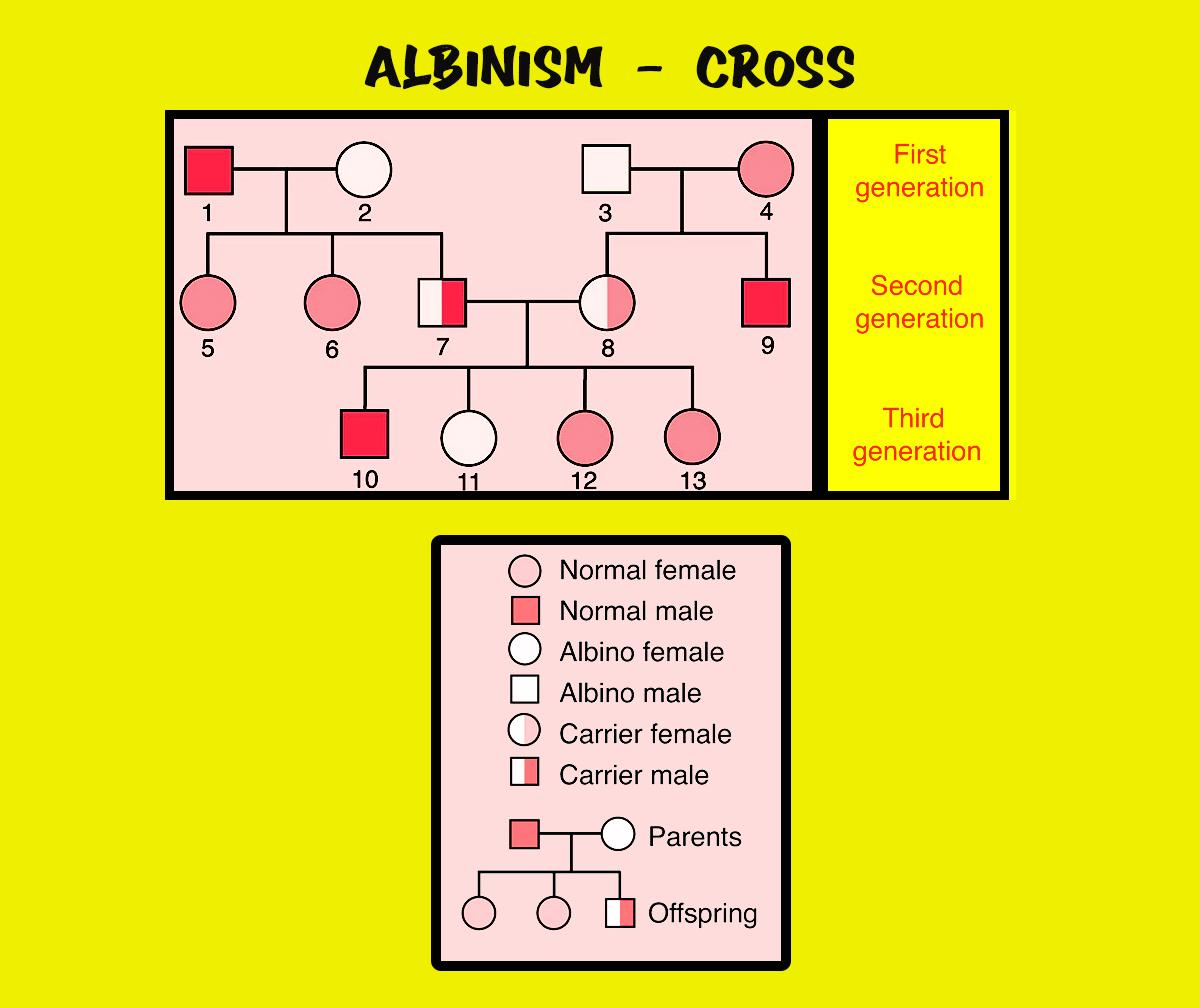
Albinism, lack of pigmentation in humans, results from an autosomal recessive gene designated 'a'. Parents with normal pigmentation have an albino child. What is the possibility that the next child is albino? What is the possibility that the next child will be an albino girl?
A)${ 1 }/{ 2 }$;${ 1 }/{ 4 }$
B)${ 1 }/{ 4 }$;${ 1 }/{ 2 }$
C)${ 1 }/{ 4 }$;${ 1 }/{ 8 }$
D)${ 1 }/{ 8 }$;${ 1 }/{ 4 }$
Answer
468.3k+ views
Hint: The production of melanin is affected by albinism and is a recessive disease. Melanin is a pigment that colors our skin, hair, and eyes. Albinism is a lifelong disorder but does not get worse over time. The people who have this condition, have a reduced amount of melanin or no melanin. Albinism can also affect coloring and the eyesight.
Complete answer:
Autosomal recessive inheritance
There are mostly two types of albinism oculocutaneous albinism(OCA) and ocular albinism(OA). They are passed in an autosomal recessive inheritance pattern.
-This means two copies of the faulty gene inherited by a child to have this condition, gene one from each parent.
-There is one in four chances that the child is carrying the albinism when both the parents carried the gene and one in two chances that their child will be a carrier(don't have urbanism but pass on to the faulty gene).
-Parents with normal pigmentation have an albino child(aa), which easily shows that both the parents carry one copy of the albino allele (a). Hence, they are the carrier of the disease.
-The genotypic ratio produced by the heterozygous parents (Aa) is AA: 2Aa: 1 aa, which shows that there is a ${ 1 }/{ 4 }$ possibility that their child is albino.
-Every time parents can have ${ 1 }/{ 2 }$ sons (XY) and ${ 1 }/{ 2 }$ daughters (XX). Show the possibility that their girl child to be albino is ${ 1 }/{ 4 }$ x ${ 1 }/{ 2 }$ = ${ 1 }/{ 8 }$
Additional Information: Symptoms of albinism
-Most people have white or very light blonde hair when affected by a condition called albinism.
-People with albinism have pale blue, grey, or brown eyes. It depends on the type of albinism and the quantity of melanin.
-The reduced amount of melanin can also cause other eye problems. This is because Milan is involved in the development of the retina, the thin layer of cells at the back of the eye.
So, the correct answer is "${ 1 }/{ 4 }$; ${ 1 }/{ 8 }$".

Note: The two main types of albinism are:
Oculocutaneous albinism OCA- the most common type affecting the skin hair and eyes.
Ocular albinism OA- a rarer type that mainly affects the eye.
Complete answer:
Autosomal recessive inheritance
There are mostly two types of albinism oculocutaneous albinism(OCA) and ocular albinism(OA). They are passed in an autosomal recessive inheritance pattern.
-This means two copies of the faulty gene inherited by a child to have this condition, gene one from each parent.
-There is one in four chances that the child is carrying the albinism when both the parents carried the gene and one in two chances that their child will be a carrier(don't have urbanism but pass on to the faulty gene).
-Parents with normal pigmentation have an albino child(aa), which easily shows that both the parents carry one copy of the albino allele (a). Hence, they are the carrier of the disease.
-The genotypic ratio produced by the heterozygous parents (Aa) is AA: 2Aa: 1 aa, which shows that there is a ${ 1 }/{ 4 }$ possibility that their child is albino.
-Every time parents can have ${ 1 }/{ 2 }$ sons (XY) and ${ 1 }/{ 2 }$ daughters (XX). Show the possibility that their girl child to be albino is ${ 1 }/{ 4 }$ x ${ 1 }/{ 2 }$ = ${ 1 }/{ 8 }$
Additional Information: Symptoms of albinism
-Most people have white or very light blonde hair when affected by a condition called albinism.
-People with albinism have pale blue, grey, or brown eyes. It depends on the type of albinism and the quantity of melanin.
-The reduced amount of melanin can also cause other eye problems. This is because Milan is involved in the development of the retina, the thin layer of cells at the back of the eye.
So, the correct answer is "${ 1 }/{ 4 }$; ${ 1 }/{ 8 }$".

Note: The two main types of albinism are:
Oculocutaneous albinism OCA- the most common type affecting the skin hair and eyes.
Ocular albinism OA- a rarer type that mainly affects the eye.
Recently Updated Pages
Master Class 12 Economics: Engaging Questions & Answers for Success

Master Class 12 Maths: Engaging Questions & Answers for Success

Master Class 12 Biology: Engaging Questions & Answers for Success

Master Class 12 Physics: Engaging Questions & Answers for Success

Master Class 12 Business Studies: Engaging Questions & Answers for Success

Master Class 12 English: Engaging Questions & Answers for Success

Trending doubts
Give simple chemical tests to distinguish between the class 12 chemistry CBSE

How was the Civil Disobedience Movement different from class 12 social science CBSE

India is the secondlargest producer of AJute Bcotton class 12 biology CBSE

Define peptide linkage class 12 chemistry CBSE

How is democracy better than other forms of government class 12 social science CBSE

Draw a labelled sketch of the human eye class 12 physics CBSE




